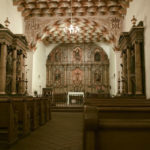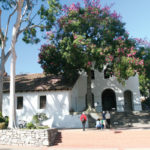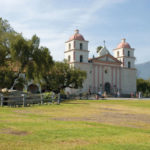
San Juan Capistrano, founded more than 200 years ago, is one of the most visited missions on the El Camino Real. The original church is now mostly ruins.
If I’d had my own car, I don’t think I ever would have received the lesson. But my car was a couple thousand miles away, the rental people had upgraded me to an SUV, and now I was about to pay for lack of fuel economy by running out of gas in the middle of nowhere in a state I didn’t even know had a middle of nowhere.
Which was not exactly the day I’d had in mind.
I’d come to California a few days earlier to follow El Camino Real, the Royal Road, which links together a chain of 21 missions spread from San Diego to north of San Francisco. Built from the mid 1700s into the early 1800s, the missions were not just churches. They were ranches, military outposts, trading posts, schools, houses, dorms, entire towns: self-contained worlds all of their own, converting the Natives with one hand on the Bible and one hand on the gun.
And they were built to be roughly a day’s travel apart by horse and foot. By car, I’d figured, planning the trip at home, I could do the whole thing in five easy days.
Except now I’m about to run out of gas and get eaten by vultures near the end of day three. I’d left the last mission, San Miguel, more than 40 miles back. The nearest gas pump is maybe 30 miles ahead, and the low-fuel warning bell is bonging with increasing frequency. Oh, and dark is coming down fast.
I should have stayed in the quiet chapel of San Miguel and prayed a while longer.

The standard mission chapel is quite simple in its construction: a long, fairly low building, wide enough for two rows of pews and a center aisle. Most are dark inside, since adobe walls made the placement of windows somewhat tricky, and most are plain. This is a bit of a surprise, since before these California missions were going up, architects throughout Mexico and Spain were going wild with the churrigueresque style in which every square inch of every available surface is decorated with cherubs, angels, and whatever else the artisans felt like carving that day.
But apparently, that’s not what California needed. A few of the missions get a bit ornate—Dolores in San Francisco is elaborate enough to make your eyes hurt—but for the most part, these are the churches of people who work hard, people who don’t need the idea of God to overwhelm them in endless scrollwork and bleeding saints.
And a lot of work it was. California State Parks has taken over La Purísima Concepción, near Lompoc, and they’ve tried hard to show what the compounds were like in their prime, when populations were in the thousands and herds of cows and flocks of sheep ran over ranches that stretched past the curve of the earth. Among the restored outbuildings are a blacksmith shop, a kitchen, the priest’s quarters, the soldiers’ quarters (rather less luxurious than where the priests lived), and more. Everything needed to bring the local Chumash under the sway of the King of Spain.
The motivating force behind the California mission trail was Father Junípero Serra, a Franciscan monk, who came to the New World from Spain in 1749. Serra was one of those great men who don’t seem to exist anymore: Whether you needed a roof fixed or were in the mood to argue the finer points of St. Aquinas’ Summa, Serra was your guy. Unless of course you wanted to have any fun, because he was pretty much dead set against that. Biographers of Father Serra write that he believed “laughter was inconsistent with the terrible responsibilities of his probationary existence.” In other words, life is a dress rehearsal for the afterlife, so take it seriously. “Not a joke or a jovial action is recorded of him.” And just in case he was having too much fun having no fun, “he considered it his duty to inflict upon himself bitter pain. He often lashed himself with ropes, sometimes of wire.”

Photo by Steve Heap.
But the man got stuff done. He founded the first nine missions on El Camino Real, from San Diego de Alcalá in 1769, to as far north as San Francisco de Asís, just a bit west of the Bay, in 1776. Before he died in 1784, he had run a total of 15 more, some on the trail, some not, as far south as Baja. Even today, the Museum of the City of San Francisco says his missions “were the first settlements of civilized man in California.” Which opens up certain problems of interpretation, Native history vs. European history, etc., but that’s not the point of this article.
At the mission in Carmel, which Serra had founded in 1771, there is a glass case near the altar. Inside the glass case lie some very old pieces of wood, the remains of Father Serra’s coffin. Sooner or later, the man is going to be made a saint—he was beatified in 1988—and when he is, this tiny, very beautiful mission by the sea is going to be even more a site of pilgrimage than it is now. “We get about 300,000 people a year,” I’m told, as I buy my ticket. Make him a saint, and I figure that number will double.
But it’s quiet right now. I stop in the courtyard, try to imagine the place as it was when an outpost on the edge of the world. Can’t do it; I’m too aware of the very expensive suburb that now surrounds the mission, the distant sound of traffic. Call it a failure of either faith or imagination. I’m not sure which.
A sign by the doorway of the chapel points out that San Carlos Borroméo de Carmelo, the mission’s full name, is in an earthquake zone, and adobe doesn’t always hold up so well in earthquakes, especially not 300-year-old adobe. I watch a couple people read the sign, peek in, then walk around to the small graveyard at the side of the church, where the graves are outlined in abalone shells the size of dinner plates, their nacreous colors catching the afternoon light and throwing it back at the church like incense.
Inside, the pew creaks, just a little, when I sit down. And that’s about the only sound I hear until I stand up again, an hour or so later, hesitant to get back in the car and back on the road. But I have more missions to see.
In all, El Camino Real stretches about 600 miles. As a practical matter, for the modern pilgrim, this means a whole lot of driving along Highway 101. By the end of the second day, I’d developed a routine. Leave one mission, set the GPS for next, never forgetting a quick prayer to Saint Christopher, because if the GPS fails, I’m going to need all the saintly intervention I can get. Drive through traffic. Repeat. But then, somewhere north of Santa Bárbara, I leave what I think of as California—a very long line of cars surrounded by pink roofs—and enter something entirely different. An emptier world, one moving at a slower pace. One where the missions still fit.

I get to three or four missions a day; each has its own unique moment of beauty. The gigantic tree in the courtyard of the mission at Santa Barbara. The smell of incense at San Buenaventura, when I walked into the chapel right after a funeral. It was the only time I went into a mission while it was being used, and for just a moment, it was as if the missions were still holding their communities together.
Over the centuries, some of the missions have become the center of towns. San Luis Obispo is huge, and, unlike the usual long, low building, is airy and L-shaped. Others, like Santa Inés, are so far off the beaten track that if the mission trail did not create a track of its own, they would have slipped completely from history. And still others, like Nuestra Señora de la Soledad, are threatening to return to the elements: The old adobe walls have melted from two centuries of rain, surviving only as stubs, like broken teeth.
I don’t see any swallows flying around San Juan Capistrano, which, of all the missions, is the one that’s most figured out how to make tourism work for it. The highest admission price, the biggest gift shop, and signs that point out the best place to watch swallows—when there are swallows to watch. And that’s the only reason most people come here, or have even heard of the place, swallows flapping back on the same day each year.
With the actual old church at Capistrano nothing but a ruin, the mission has consecrated a small chapel for prayers: And here, it’s the usual long, low box of a room, two cramped aisles of pews. But there’s also the most elaborate altar of any of the missions, and the racks of burning candles make the gold reredos glisten as if wet with new rain.
It is after visiting San Miguel Arcángel—founded in 1797 and now the most complete original chapel—that I find myself in trouble. The chapel is so beautiful, so peaceful, not another person inside, that I linger maybe a bit too long. And when I finally leave, I discover that my plan—buy gas near here before going on to San Antonio—was a bad one. No gas stations. Okay, fine. Map shows a town down the road, they’ll have gas.
Except they don’t. “We like it that way,” says the man in the lone business in the town of … well, I can’t exactly tell where I am, because what I thought was a town on the map was really just a crossroads, and the GPS kind of gave up in disgust a half hour ago. “But the military base might sell you a few gallons.”
The air outside smells like onions, like farms. Back when the missions were first built, all of California was this empty.
What we forget, rolling along so easily in our cars—what I’m about to remember as my car sucks the last fumes out of the gas tank before the military base really does take pity on me and sells me enough fuel to get to the next mission and the next town—is that it wasn’t long ago, not long at all, when the world was a much bigger place, a place where you needed to know there was something familiar at the end of the day. A star to point yourself toward.
Father Serra saw all this space as a clean slate—never mind the people already living there—and thought, yes, I can do something with that. I can do something that lasts, that matters. I can make something beautiful.
And so he started building missions. A place to rest from work. A chance to touch something bigger than even the vast emptiness of the landscape.
I light a candle of thanks in San Antonio, throw a little extra light on the world, climb in the car to the sound of screeching chickens. The mission waits for its next visitor.
Gallery: El Camino Real, the Royal Road
Become a Saturday Evening Post member and enjoy unlimited access. Subscribe now













Comments
I was there this past summer. It was very intresting,beautiful, and messmerising. I hightly invite others to see it .